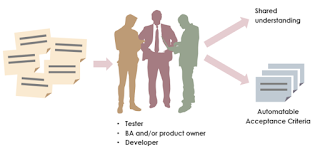“The Three Amigos” refers to a meeting of the minds of the three primary roles
involved in producing software:
1. Business – Often named the “business analyst” (BA) or “product owner” (PO),
the business role provides what problem must be solved.
They provide requirements for the solution. Typically, the business role is
non-technical.
2. Development – The developer role provides how the solution to
the problem will be implemented. They build the software and must be very
technical.
3. Testing – The testing role, sometimes named “quality assurance” (QA),
verifies that the delivered software product works correctly. They
also try to find defects. The tester role must be somewhat technical.
During software
development, The Three Amigos should meet regularly to discuss how the product
will be developed. It is a shift left practice to avoid misunderstandings, thus
improving quality and avoiding missed deadlines. The discussions should include
only the individuals who will actually work on the specific deliverable, not
the whole team.
While The Three
Amigos seems most popular in Agile, it can be applied to any software
development process. Some advocate regularly scheduled formal meetings. Others interpret
it as an attitude instead of a process, in which the roles continuously
collaborate. Regardless of implementation, The Three Amigos need to touch base
before development begins.
Applying BDD
The Three Amigos
fits perfectly into behavior-driven development, especially as part of BDD with
Agile. Behavior scenarios are meant to foster collaboration between technical
and non-technical roles because they are simple, high-level, and written in
plain language. Given-When-Then provides a common format for discussion.
Ideally, when The
Three Amigos meet during grooming and planning, they would formalize acceptance
criteria as Gherkin features. Those feature files are then used directly by the
developer for direction and the tester for automation. They act like a receipt
of purchase for the business role – the feature file says, “This is what you
ordered.”
Since BDD relies
on feature files as artifacts, The Behavior-Driven Three Amigos must be more
than just an attitude. The point of the collaboration is to produce feature
files early for process efficiency. Less formal meetings could quickly devolve
into all-talk-no-action.


